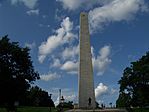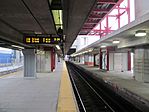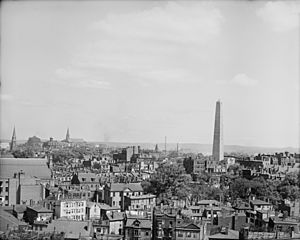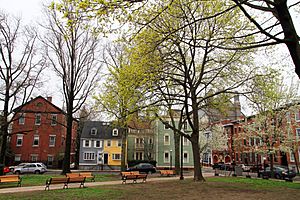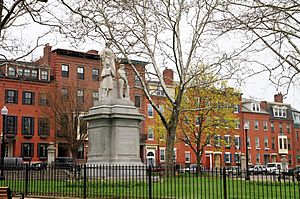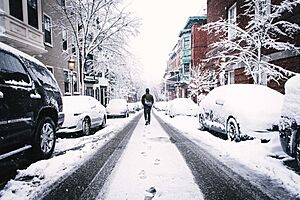Charlestown, Boston facts for kids
Quick facts for kids
Charlestown
|
||
|---|---|---|
|
Left-right from top: Houses in Charlestown, Bunker Hill Monument, Spaulding Rehabilitation Hospital, Community College MBTA station
|
||
|
||
| Motto(s):
Liberty A Trust To Be Transmitted To Posterity
|
||
| Country | United States | |
| State | Massachusetts | |
| City | Boston | |
| Settled | 1628 | |
| Incorporated (Town) | 1628 | |
| Incorporated (City) | 1847 | |
| Annexed by Boston | 1874 | |
| Named for | King Charles I | |
| Time zone | UTC-5 (Eastern) | |
| • Summer (DST) | UTC-4 (Eastern) | |
| Zip Code |
02129
|
|
| Area code(s) | 617/857 | |
Charlestown is the oldest neighborhood in Boston, Massachusetts, in the United States. The Massachusett people called it Mishawum. It is located on a piece of land called a peninsula. This land is north of the Charles River and next to the Mystic River and Boston Harbor.
Charlestown was planned in 1629 by an engineer named Thomas Graves. This happened during the time of Charles I of England. It was first its own town and the very first capital of the Massachusetts Bay Colony.
Charlestown became a city in 1848. Then, on January 5, 1874, it became part of Boston. It also moved from Middlesex County to Suffolk County. Many Irish-American people have lived here since the Great Irish Famine in the 1840s.
Since the late 1980s, the neighborhood has changed a lot. This is because it is close to downtown Boston and has beautiful old buildings. Many new people have moved in, but Charlestown still has a strong Irish-American community. Today, it is mostly a place where people live. Many homes are near the water, with views of the Boston skyline. Charlestown has many historic places, hospitals, and organizations. You can get there by train (Orange Line) or by car (I-93).
Contents
History of Charlestown
The first English settlers on the peninsula were Thomas and Jane Walford. They arrived in 1624 at the place they called Mishawaum. John Endecott, the first governor of Massachusetts Bay Colony, sent people to plan a settlement. Thomas Walford helped by talking with the local sachem (Native American leader) Wonohaquaham. This allowed Endicott's group to settle there.
Charlestown was founded in 1628 by English Puritans. It was settled on July 4, 1629, by Thomas Graves and about 100 others. In 1630, John Winthrop's group stayed here before moving across the Charles River to settle in Boston.
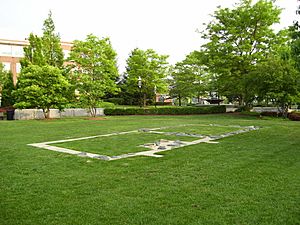
The area of Charlestown was very large at first. Over time, many towns became separate from it. These included Woburn (1642), Melrose and Malden (1649), Stoneham (1725), and Somerville (1842). Other towns like Everett, Burlington, Medford, Arlington, and Cambridge also took parts of Charlestown's original land.
On June 17, 1775, the Charlestown Peninsula was where the Battle of Bunker Hill took place. This famous battle was named after a hill near Sullivan Square. Most of the fighting happened on Breed's Hill. British troops landed nearby, and the town was almost completely destroyed by the British during the battle.
Charlestown was rebuilt after the war. In 1786, the first bridge connecting Boston with Charlestown was built over the Charles River. A large Navy Yard was started in 1800. The Charlestown State Prison opened in 1805. The Bunker Hill Monument was built between 1827 and 1843. It used granite brought by a special railway and boats.
Around the 1860s, many Irish immigrants came to Charlestown. The area became known for its strong Irish and Catholic community. People from Charlestown are sometimes called "Townies." This nickname often refers to the working-class Irish families who have lived there for a long time.
During the American Civil War, over 26,000 men joined the Union Army and Navy at the Navy Yard. The Navy Yard also built famous ships for the war, like the Merrimack and the Hartford. After the war, a memorial for the Civil War was built in 1872. It still stands in the Training Field.
Charlestown got its own water supply from the Mystic Lakes. On October 7, 1873, people voted to join Boston. Most residents in both Charlestown and Boston agreed to the merger. Charlestown's separate city government ended the next year.
In the early 1960s, there were plans to tear down many homes in Charlestown. But residents strongly opposed this idea. By 1965, the plan was much smaller. Only a small part of the neighborhood was torn down. Also, the elevated train tracks were removed.
Starting in the 1980s, many new people moved to Charlestown. They were attracted to its closeness to downtown and its historic brick homes. This brought changes to the neighborhood, similar to other parts of Boston.
Today, Charlestown is one of Boston's oldest neighborhoods. It is home to the Bunker Hill Monument and the historic Charlestown Navy Yard. It is mostly a residential area. Important places include Bunker Hill Community College and Spaulding Rehabilitation Center. The Navy Yard is now a national park. The waterfront has two marinas for boats.
Geography of Charlestown
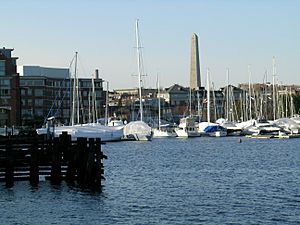
Charlestown is north of downtown Boston. It is on a peninsula that stretches southeast. This land is between the Charles River and the Mystic River. The size of the neighborhood has changed a lot since colonial times.
People have added land by filling in water, which is called landfill. This has made Boston and Charlestown larger. It also removed the narrow "Charlestown Neck" that connected the peninsula to the mainland. The original area of Charlestown also included what is now Somerville and part of Arlington.
City Square is in the southern part of Charlestown. It is where the old city hall is located. It is also where the Charlestown Bridge ends. This area used to have elevated roads, but they were moved underground. Now, it is a nice park.
Thompson Square is where several streets meet. It was also once a stop for the elevated train.
Arts and Culture in Charlestown
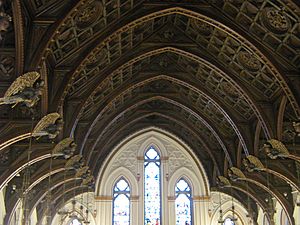

Charlestown has many interesting historical places. Some of these are part of Boston's Freedom Trail. The Freedom Trail ends at the Bunker Hill Monument. This monument remembers the famous Battle of Bunker Hill from the American Revolutionary War.
The USS Constitution is a very old ship. It was launched in 1797. It is the oldest ship in the US Navy that is still in use and still floats. Today, you can see it at the Charlestown Navy Yard. This Navy Yard is now part of the National Park Service.
Charlestown was also where Paul Revere started his famous "midnight ride." This ride happened before the Battles of Lexington and Concord. A restaurant called Warren Tavern opened in 1780. It claims to have been one of Revere's favorite places. It was one of the first buildings put up after the Battle of Bunker Hill. The tavern is named after Joseph Warren, a hero of the American Revolution.
Demographics of Charlestown
| Historical population | |||
|---|---|---|---|
| Census | Pop. | %± | |
| 1800 | 2,751 | — | |
| 1810 | 4,959 | 80.3% | |
| 1820 | 6,591 | 32.9% | |
| 1830 | 8,783 | 33.3% | |
| 1840 | 11,484 | 30.8% | |
| 1850 | 17,216 | 49.9% | |
| 1860 | 25,065 | 45.6% | |
| 1870 | 28,323 | 13.0% | |
In 2007–2011, Charlestown had about 16,685 people. The largest age group was 25 to 29 years old. Most of the people (about 75%) were white. Other groups included Black or African, Asian, and Hispanic or Latino people. The number of minority groups has grown a lot in recent years.
The average household income was about $89,017. The average family income was about $100,725.
About 17% of all people and 37% of children lived below the Federal Poverty Line. This means they had very low incomes.
Who Lives in Charlestown?
| Race | Percentage of 02129 population |
Percentage of Massachusetts population |
Percentage of United States population |
ZIP Code-to-State Difference |
ZIP Code-to-USA Difference |
|---|---|---|---|---|---|
| White | 75.3% | 81.3% | 76.6% | –6.0% | –1.3% |
| White (Non-Hispanic) | 70.6% | 72.1% | 60.7% | –1.5% | +9.9% |
| Hispanic | 11.5% | 11.9% | 18.1% | –0.4% | –6.6% |
| Black | 11.1% | 8.8% | 13.4% | +2.3% | –2.3% |
| Asian | 7.6% | 6.9% | 5.8% | +0.7% | +2.8% |
| Native Americans/Hawaiians | 0.0% | 0.6% | 1.5% | –0.6% | –1.5% |
| Two or more races | 2.1% | 2.4% | 2.7% | –0.3% | –0.6% |
According to a 2012–2016 survey, the largest ancestry groups in Charlestown (ZIP Code 02129) are:
| Ancestry | Percentage of 02129 population |
Percentage of Massachusetts population |
Percentage of United States population |
ZIP Code-to-State Difference |
ZIP Code-to-USA Difference |
|---|---|---|---|---|---|
| Irish | 42.20% | 21.16% | 10.39% | +21.05% | +31.82% |
| Italian | 15.18% | 13.19% | 5.39% | +1.99% | +9.78% |
| German | 10.55% | 6.00% | 14.40% | +4.54% | –3.86% |
| English | 10.07% | 9.77% | 7.67% | +0.29% | +2.40% |
| Chinese | 5.59% | 2.28% | 1.24% | +3.31% | +4.35% |
| American | 5.48% | 4.26% | 6.89% | +1.21% | –1.42% |
| Polish | 5.08% | 4.67% | 2.93% | +0.41% | +2.14% |
| West Indian | 4.18% | 1.96% | 0.90% | +2.22% | +3.27% |
| Sub-Saharan African | 3.52% | 2.00% | 1.01% | +1.52% | +2.50% |
| French | 3.36% | 6.82% | 2.56% | –3.46% | +0.80% |
| Scottish | 3.13% | 2.28% | 1.71% | +0.85% | +1.42% |
| Haitian | 2.78% | 1.15% | 0.31% | +1.62% | +2.47% |
| European | 2.33% | 1.08% | 1.23% | +1.25% | +1.10% |
| Russian | 2.12% | 1.65% | 0.88% | +0.47% | +1.24% |
| French Canadian | 1.88% | 3.91% | 0.65% | –2.02% | +1.23% |
| Cape Verdean | 1.63% | 0.97% | 0.03% | +0.66% | +1.60% |
| Portuguese | 1.56% | 4.40% | 0.43% | –2.84% | +1.13% |
| Eastern European | 1.36% | 0.42% | 0.17% | +0.94% | +1.19% |
| Greek | 1.33% | 1.22% | 0.40% | +0.11% | +0.93% |
| Puerto Rican | 1.33% | 4.52% | 1.66% | –3.19% | –0.33% |
| Dutch | 1.00% | 0.62% | 1.32% | +0.38% | –0.32% |
Healthcare in Charlestown
Charlestown has important healthcare facilities.
- Mass General: Charlestown Healthcare Center is part of Massachusetts General Hospital. It has served the community since 1968. This center works with local schools and groups. They create programs that help Charlestown's diverse population.
- Spaulding Rehabilitation Hospital has an outpatient facility here. This means people can visit for treatment without staying overnight.
Transportation in Charlestown
Interstate 93 (the "Northern Expressway viaduct") runs through the Sullivan Square area. It forms a border for Charlestown. Only two roads go west from Charlestown: Cambridge Street and Austin Street/Gilmore Bridge. US 1 splits from I-93 at the Leonard P. Zakim Bunker Hill Memorial Bridge. US 1 then becomes a toll road and goes under Paul Revere Park and City Square. It then becomes the Tobin Bridge across the Mystic River to Chelsea.
State roads like Route 38 (to Somerville) and Route 99 (to Everett) also pass through Charlestown. The only city road connecting Charlestown to downtown Boston is North Washington Street.
Most people in Charlestown (about 53.7%) drive to work. About 30% use public transportation. Charlestown has good public transport options. You can get there by train, bus, and ferry.
The train is the MBTA Orange Line. There are two stations:
- The Community College station is near Bunker Hill Community College. It serves the center of town.
- The Sullivan Square station is on what was once a narrow strip of land called the Charlestown Neck.
Two bus lines serve Charlestown. Both start at Sullivan Square and go to the Financial District downtown.
- The 93 bus goes from Sullivan Station downtown, passing through Bunker Hill Street.
- The 92 bus runs from Assembly Square Mall downtown, via Sullivan Square Station and Main Street.
You can also reach Charlestown by ferry. The MBTA runs a ferry between the Charlestown Navy Yard and Long Wharf (near the New England Aquarium). This is a popular way for both commuters and tourists to travel.
The Boston Harborwalk and the Freedom Trail also go through the neighborhood.
Notable People from Charlestown
Many interesting people have connections to Charlestown:
- Charles R. Adams (1834–1900), an opera singer born in Charlestown.
- Charles B. Atwood (1849–1895), an architect who designed famous buildings.
- William Austin (1778–1841), a writer and state lawmaker.
- Loammi Baldwin (1780–1838), a civil engineer.
- Albert Gallatin Blanchard (1810–1891), a Confederate general in the American Civil War.
- Shano Collins (1885–1955), a baseball player for the Boston Red Sox and Chicago White Sox.
- Thomas Dalton (1794–1883) and his wife Lucy, who fought against slavery.
- Samuel Dexter (1761–1816), a well-known lawyer and government official.
- James Frothingham (1786–1864), a portrait artist.
- Nathaniel Gorham (1738–1796), a member of the Continental Congress.
- Matt Grzelcyk (b. 1994), an NHL hockey player for the Boston Bruins.
- John Harvard (1607–1638), who gave money to start Harvard University.
- Oliver Holden (1765–1831), a composer of hymns.
- Howie Long (b. 1960), a famous football player and TV commentator.
- Samuel F. B. Morse (1791–1872), who invented the telegraph and Morse code.
- Jack O'Callahan (b. 1957), a hockey player who was part of the "Miracle On Ice" team.
- John Boyle O'Reilly (1844–1890), an Irish poet and writer who lived in Charlestown.
- Robert Sedgwick (c.1611–1656), an English merchant and military leader.
- Daniel C. Stillson (1830–1899), who invented the Stillson pipe wrench.
Images for kids



